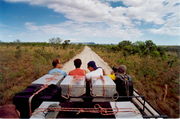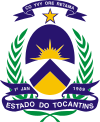Tocantins
| State of Tocantins | |||
|---|---|---|---|
| — State — | |||
|
|||
 |
|||
| Country | |||
| Capital and Largest City | Palmas | ||
| Government | |||
| - Governor | Carlos Henrique Gaguim[1] (PMDB) | ||
| Area | |||
| - Total | 277,620.91 km2 (107,190 sq mi) | ||
| Area rank | 10th | ||
| Population (2005 census) | |||
| - Total | 1,307,818 | ||
| - Estimate (2006) | 1,332,441 | ||
| - Rank | 24th | ||
| - Density | 4.7/km2 (12.2/sq mi) | ||
| - Density rank | 22nd | ||
| Demonym | Tocantinense | ||
| GDP | |||
| - Year | 2006 estimate | ||
| - Total | R$ 9,607,000,000 (24th) | ||
| - Per capita | R$ 7,210 (17th) | ||
| HDI | |||
| - Year | 2005 | ||
| - Category | 0.756 – medium (14th) | ||
| Time zone | BRT (UTC-3) | ||
| - Summer (DST) | BRST (UTC-2) | ||
| Postal Code | 77000-000 to 77990-000 | ||
| ISO 3166 code | BR-TO | ||
| Website | to.gov.br | ||
Tocantins (Tupi: Bico de Tucano or Toucan Beak) (Portuguese pronunciation: [tokɐ̃ˈtʃĩs][2]) is one of the states of Brazil. The state was formed in 1988 out of the northern part of Goiás, and construction began on the capital, Palmas, in 1989, in contrast to most of the other cities in the state which date back to the Portuguese colonial period. It is the newest Brazilian state and, because it is still very young, it is developing slowly, building on its most important resources: the rivers Araguaia and Tocantins, the largest hydro basin entirely inside Brazilian territory. Because it is in the central zone of the country, it has characteristics of the Amazon, but also has open pastures.
The Ilha do Bananal, in the southwest of the State, is the largest fluvial island in the world. Tocantins is also home to the National Park of Araguaia and the Carajás Indian reservations. Another highlight is the Jalapão, about 250 kilometers from the capital, Palmas. There, the rivers create true oases in the dry landscape, attracting many ecotourists to the region.
Contents |
Geography

Tocantins forms the boundary between the Amazon Rainforest and the coastal savanna. As a result, the state's geography is varied. Many rivers cross through the state (including one of the same name), and there are over 20 archaeologically significant sites found in Tocantins.
Climate

Most os of Tocantins(except the extreme west and northern regions) is situated within a vast Brazilian area known as the cerrado. The cerrado region's typical climate is hot, semi-humid, with pronounced seasonality marked by a dry winter season from May through October. The annual rainfall is around 800 to 1600 mm. The soils are generally very old, deep, and naturally nutrient poor.
Vegetation
The "cerrado" landscape is characterized by extensive savanna formations crossed by gallery forests and stream valleys. Cerrado includes various types of vegetation. Humid fields and "buriti" palm paths are found where the water table is near the surface. Alpine pastures occur at higher altitudes and mesophytic forests on more fertile soils.
The savanna formations are not homogenous. There is great variation between the amount of woody and herbaceous vegetation, forming a gradient from completely open "cerrado" — open fields dominated by grasses — to the closed, forest-like "cerrado" and the "cerradão" ("big cerrado"), a closed canopy forest. Intermediate forms include the dirty field, the "cerrado" field, and the "cerrado" sensu stricto, according to a growing density of trees.
The "cerrado" trees have characteristic twisted trunks covered by a thick bark, and leaves which are usually broad and rigid. Many herbaceous plants have extensive roots to store water and nutrients. The plant's thick bark and roots serve as adaptations for the periodic fires which sweep the cerrado landscape. The adaptations protect the plants from destruction and make them capable of sprouting again after the fire.[2]
As in many savannas in the world, the "cerrado" ecosystems have been coexisting with fire since ancient times; initially as natural fires caused by lightning or volcanic activity, and later caused by man.
Only the extreme north of Tocantins has feutures of an Amazon Rain Forest. The western boundary of the state has extensive swamps within the floodplain of Araguaia River. Bananal island, within the fork of Araguaia, is said to be the largest river island in the world.]</ref>
History
Jesuit missionaries explored what is today Tocantins state about 1625, seeking to convert the Amerindian peoples of the area to Christianity. The area is named after the Tocantins River, which in turn is an indigenous name.
Before 1988 the area was part of the Goiás state, in the north of the state. However, ever since the 1600s, the north has been isolated and difficult to access. As a result, the southern area of the state became more developed, and there had been a strong separatist movement in the north for many years.
The first large scale stirrings of separatism were in 1809, when heavy taxes were levied on mining. This led to a minor revolt which was quickly crushed by the army. A string of failed uprisings occurred in the 19th century.
In the 1970s, pressure was put on the federal government by the northern Goiás population for a separate state, and in the 1988 Constitution, Tocantins state was officially created.
Since its establishment, Tocantins has been the fastest-growing Brazilian state, with a thriving economy based on agriculture and agro-industry which attracts immigrants from all over the country. The construction of the long-planned North-South Railway (Brazil) will probably boost the economic growth even more. Tocantins is also considered one of the best-managed Brazilian states.
Demographics
According to the IBGE of 2007, there were 1,377,000 people residing in the state. The population density was 4.8 inh./km².
Urbanization: 71.5% (2004); Population growth: 2.6% (1991–2000); Houses: 355,502 (2005).[3]
The last PNAD (National Research for Sample of Domiciles) census revealed the following numbers: 948,000 Brown (Multiracial) people (68.9%), 330,000 White people (24.0%), 95,000 Black people (6.9%), 2,000 Asian or Amerindian people (0.2%).[4]
Economy
The service sector is the largest component of GDP at 59.9%, followed by the industrial sector at 27.2%. Agriculture represents 12.9% of GDP (2004). Tocantins exports: soybean 89.2%, beef 10.5% (2002).
Share of the Brazilian economy: 0.4% (2005).
As with much of Brazil, Tocantins' economy is dependent on cattle raising, though the state's pineapple plantations not only supply much of Brazil with the fruit, but also many other Mercosul nations with it too. In the state's north, charcoal and oils are extracted from the babaçu palm tree.
The federal government, seeking to broaden Tocantins' economic base by funding the construction of a hydroelectric dam in the state, allowed a private company to construct a sizable five-turbine hydroelectric dam, blocking the Tocantins river and displacing some indigenous inhabitants. However, its contribution to the state is indisputable - one turbine alone powers the entire state of Tocantins while the remaining four provide electricity which is sold to other parts of Brazil.
Education
Portuguese is the official national language, and thus the primary language taught in schools. But English and Spanish are part of the official high school curriculum.
Educational institutions
- Universidade Federal do Tocantins (UFT) (Federal University of Tocantins);
- Fundação Universidade do Tocantins (Unitins) (Foundation University of Tocantins);
- Escola Técnica Federal de Palmas (ETF-TO);
- Faculdade de Tecnologia de Palmas (FTP);
- Fundação Unirg (Unirg) (Foundation Unirg);
- and many others.
Infrastructure
National Airport
The facility occupies one of Brazil’s largest airport sites and has privileged location near the Lageado Hydroelectric Station. Designed with a modern concept of visual communication, the new Palmas Airport Complex contains an Aeroshopping area, a program developed by Infraero aiming to turn Brazil’s main airports into true commercial centers with their own brand and identity. The passenger terminal has 12.300 square meters of constructed area and capacity to serve up to 370 thousand people a year. It has a food court, cultural space, shops, panoramic deck, elevators and air conditioning. The runway can receive aircraft the size of a Boeing 767. There are three taxiways and aprons for general aviation, making operations more flexible. The airport has full infrastructure that includes a control tower and installations for the Air Navigation Group, fire brigade, a covered equipment parking area, canteen and training rooms, two aircraft fueling stations, a gate with electronic entry control, guard booths. parking and flight protection buildings, besides a 4 km (2.48 mi) access road linking the airport to the Tocantins capital city’s main thoroughfare.
Highways
BR-153, BR-010, BR-226, BR-230, BR-235, BR-242, TO-348, TO-164.
Flag
The message of the flag is the phrase "where the sun rises for all". In the middle of the flag is the golden yellow sun, with its rays symbolically targeting to the future of the state. The sun is placed on a white band, where the white color represents peace. The blue in the upper left and the yellow in the bottom right represent the waters and the soil of the state. The colors date back to a flag used by the Autonomous Government of Palmas in the 19th century.
The flag was adopted with the state flag law (law no 094/89) of November 17, 1989.
Cities
Other cities include:
- Tocantinópolis
- Colinas do Tocantins
- Araguaína
- Gurupi
- Palmas
- Dianópolis
- Porto Nacional
Popular culture
Survivor: Tocantins - The Brazilian Highlands was the eighteenth season of the United States reality show Survivor filmed in the microregion of Jalapão in Tocantins. The premiere aired Thursday, February 12, 2009.
References
- ↑ ""Assembleia empossa novo governador do Tocantins"" (in "Portuguese"). "Assembleia Legislativa do Estado do Tocantins". http://www.al.to.gov.br/noticias.swd?codigo=18383.
- ↑ The presented pronunciation is in Brazilian Portuguese variant spoken in Tocantins (and most of Brazil). The European Portuguese pronunciation is [tokɐ̃ˈtĩʃ].
- ↑ Source: PNAD.
- ↑ (in Portuguese) (PDF) Síntese de Indicadores Sociais 2007. Tocantins, Brazil: IBGE. 2007. ISBN 85-240-3919-1. ftp://ftp.ibge.gov.br/Indicadores_Sociais/Sintese_de_Indicadores_Sociais_2007/Tabelas. Retrieved 2007-07-18.
External links
- (Portuguese) Tocantins Official Website
- (English) Tocantins Official International Website
- (English) Tourism in Jalapão, Tocantins
- (English) List of cities in Brazil (all cities and municipalities)
|
||||||||||||||||||||||||||||||||||||||
|
||||||||||||||||||||||||||||||||
|
||||||||||||||||||||

